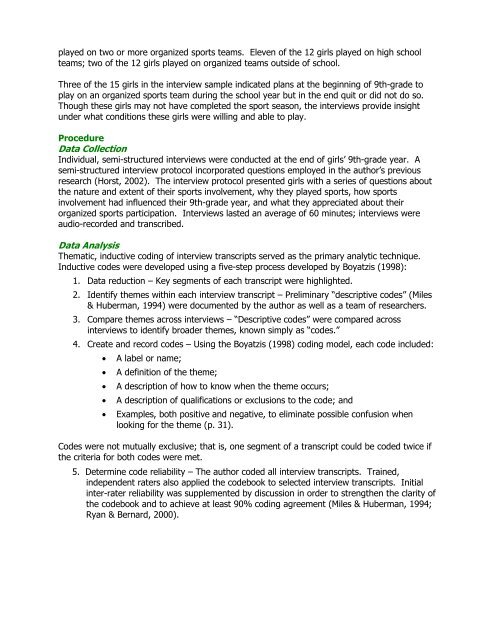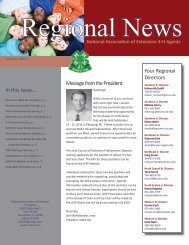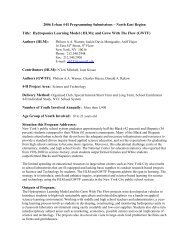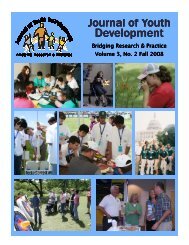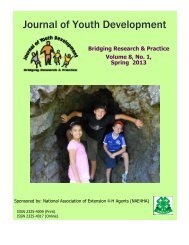Winter 2008 - Vol. 3 No. 3 - National Association of Extension 4-H ...
Winter 2008 - Vol. 3 No. 3 - National Association of Extension 4-H ...
Winter 2008 - Vol. 3 No. 3 - National Association of Extension 4-H ...
- No tags were found...
Create successful ePaper yourself
Turn your PDF publications into a flip-book with our unique Google optimized e-Paper software.
played on two or more organized sports teams. Eleven <strong>of</strong> the 12 girls played on high schoolteams; two <strong>of</strong> the 12 girls played on organized teams outside <strong>of</strong> school.Three <strong>of</strong> the 15 girls in the interview sample indicated plans at the beginning <strong>of</strong> 9th-grade toplay on an organized sports team during the school year but in the end quit or did not do so.Though these girls may not have completed the sport season, the interviews provide insightunder what conditions these girls were willing and able to play.ProcedureData CollectionIndividual, semi-structured interviews were conducted at the end <strong>of</strong> girls’ 9th-grade year. Asemi-structured interview protocol incorporated questions employed in the author’s previousresearch (Horst, 2002). The interview protocol presented girls with a series <strong>of</strong> questions aboutthe nature and extent <strong>of</strong> their sports involvement, why they played sports, how sportsinvolvement had influenced their 9th-grade year, and what they appreciated about theirorganized sports participation. Interviews lasted an average <strong>of</strong> 60 minutes; interviews wereaudio-recorded and transcribed.Data AnalysisThematic, inductive coding <strong>of</strong> interview transcripts served as the primary analytic technique.Inductive codes were developed using a five-step process developed by Boyatzis (1998):1. Data reduction – Key segments <strong>of</strong> each transcript were highlighted.2. Identify themes within each interview transcript – Preliminary “descriptive codes” (Miles& Huberman, 1994) were documented by the author as well as a team <strong>of</strong> researchers.3. Compare themes across interviews – “Descriptive codes” were compared acrossinterviews to identify broader themes, known simply as “codes.”4. Create and record codes – Using the Boyatzis (1998) coding model, each code included:• A label or name;• A definition <strong>of</strong> the theme;• A description <strong>of</strong> how to know when the theme occurs;• A description <strong>of</strong> qualifications or exclusions to the code; and• Examples, both positive and negative, to eliminate possible confusion whenlooking for the theme (p. 31).Codes were not mutually exclusive; that is, one segment <strong>of</strong> a transcript could be coded twice ifthe criteria for both codes were met.5. Determine code reliability – The author coded all interview transcripts. Trained,independent raters also applied the codebook to selected interview transcripts. Initialinter-rater reliability was supplemented by discussion in order to strengthen the clarity <strong>of</strong>the codebook and to achieve at least 90% coding agreement (Miles & Huberman, 1994;Ryan & Bernard, 2000).


